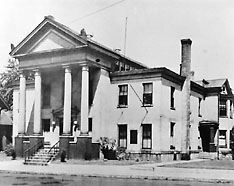CITYSCAPES
McCulloch on the mend
By KEVIN LEININGER
from the archives of The News-Sentinel
 |
Time has not been kind to the McCulloch House at 616 W. Superior St.
Once the home of one of the nation's most prominent financiers, the house
has since played host to a medical school, the Turners Athletic Club, the Fort
Wayne Poster Co., and an electricians' union. Since the union moved out four
years ago, the place has been host only to parasites and vandals.
But things may be improving, says Karen Anderson, executive director of
historic preservation group Arch.
Arch, which has owned the property since 1978, has had several offers for
the house. Anderson said there have been suggestions the house be renovated
into a dinner theater, apartments, a restaurant or offices. Right now,
Anderson said, the office idea seems most likely.
The house's location, once considered out of the way, now is much more
attractive because of the new bridge just a block to the east.
The house itself has endured several changes since it was completed in 1843
by Hugh McCulloch, who served as U.S. treasurer and secretary of the treasury
under Lincoln. The tower visible in the heavily retouched old photograph has
long since disappeared, although its foundation is still visible in the
basement.Of particular interest in the old photograph is the lushly landscaped lawn,
which used to be in front of the house until Superior Street (originally
called Water Street) was constructed.
Anderson said
several improvements - including perhaps, a new roof - will be necessary to
make the old house habitable again.
Although the house is still in rough shape, its condition has improved a
bit in the past year. Last year, Arch spent two days removing the trash that
had accumulated in the house over the decades. It took several trucks to haul
the garbage away.
Despite the McCulloch Houses's present state, things could be worse. Last
year, the house was almost sold at public auction when Arch was late paying
$1,412 in property taxes. Arch finally raised the necessary funds to win a
stay of execution for the house. And now Anderson and other preservationists
are optimistic of a bright future for what they consider to be one of the most
historically significant homes still standing in Fort Wayne.
(Editor's note, February 1997: The building was rehabilitated as planned and is in use today.)
--Aug. 22, 1982
